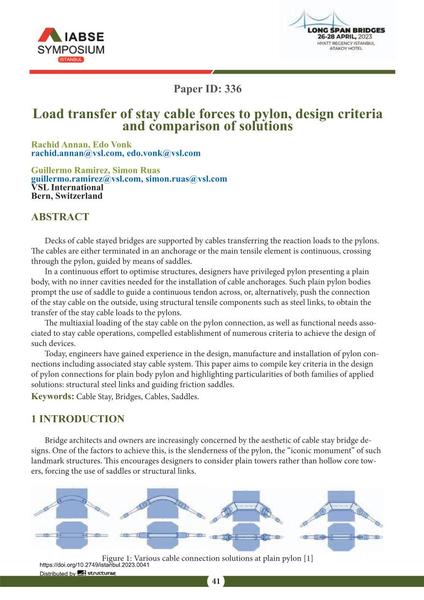Load transfer of stay cable forces to pylon, design criteria and comparison of solutions

|
|
|||||||||||
Bibliographic Details
| Author(s): |
Rachid Annan
(VSL International, Bern, Switzerland)
Edo Vonk (VSL International, Bern, Switzerland) Guillermo Ramirez (VSL International, Bern, Switzerland) Simon Ruas (VSL International, Bern, Switzerland) |
||||
|---|---|---|---|---|---|
| Medium: | conference paper | ||||
| Language(s): | English | ||||
| Conference: | IABSE Symposium: Long Span Bridges, Istanbul, Turkey, 26-28 April 2023 | ||||
| Published in: | IABSE Symposium Istanbul 2023 | ||||
|
|||||
| Page(s): | 41-51 | ||||
| Total no. of pages: | 11 | ||||
| Year: | 2023 | ||||
| DOI: | 10.2749/istanbul.2023.0041 | ||||
| Abstract: |
Decks of cable stayed bridges are supported by cables transferring the reaction loads to the pylons. The cables are either terminated in an anchorage or the main tensile element is continuous, crossing through the pylon, guided by means of saddles. In a continuous effort to optimise structures, designers have privileged pylon presenting a plain body, with no inner cavities needed for the installation of cable anchorages. Such plain pylon bodies prompt the use of saddle to guide a continuous tendon across, or, alternatively, push the connection of the stay cable on the outside, using structural tensile components such as steel links, to obtain the transfer of the stay cable loads to the pylons. Toe multiaxial loading of the stay cable on the pylon connection, as well as functional needs associated to stay cable operations, compelled establishment of numerous criteria to achieve the design of such devices. Today, engineers have gained experience in the design, manufacture and installation of pylon connections including associated stay cable system. This paper aims to compile key criteria in the design of pylon connections for plain body pylon and highlighting particularities of both families of applied solutions: structural steel links and guiding friction saddles. |
||||
| Keywords: |
bridges ropes cables saddles cable stay
|
||||

